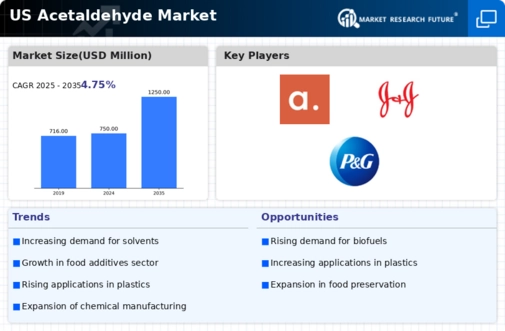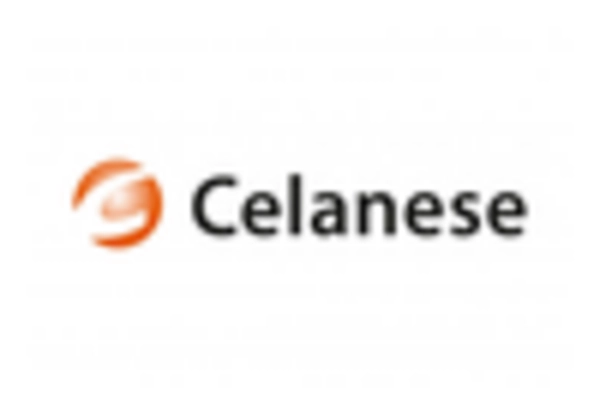Growing Industrial Applications
The acetaldehyde market is experiencing growth due to its increasing use in various industrial applications. Acetaldehyde serves as a key intermediate in the production of acetic acid, which is essential for the manufacture of plastics, textiles, and food additives. In 2025, the demand for acetic acid in the US is projected to reach approximately 16 million metric tons, with acetaldehyde playing a crucial role in this supply chain. Additionally, the chemical is utilized in the synthesis of various chemicals, including butyraldehyde and pentaerythritol, further driving its market presence. As industries expand and diversify, the acetaldehyde market is likely to benefit from this growing demand, indicating a robust future for producers and suppliers alike.
Advancements in Production Technologies
The acetaldehyde market is benefiting from advancements in production technologies that enhance efficiency and reduce costs. Innovations in catalytic processes and raw material sourcing are enabling manufacturers to produce acetaldehyde more sustainably and economically. For instance, the development of more efficient catalysts has the potential to increase yield rates while minimizing waste. As production costs decrease, the market may see a surge in competitiveness, allowing for lower prices and increased accessibility of acetaldehyde. This technological evolution is likely to attract new entrants into the acetaldehyde market, further stimulating growth and innovation within the industry.
Regulatory Support for Chemical Production
The acetaldehyde market is positively influenced by regulatory frameworks that support chemical production in the US. Government policies aimed at promoting domestic manufacturing and reducing reliance on imports create a favorable environment for acetaldehyde production. The US Environmental Protection Agency (EPA) has established guidelines that encourage the safe use and production of chemicals, including acetaldehyde. This regulatory support not only enhances the market's stability but also fosters innovation in production processes. As a result, manufacturers are likely to invest in expanding their production capacities, which could lead to an increase in the overall market size. The acetaldehyde market is thus positioned to thrive under these supportive regulations.
Rising Demand in the Food and Beverage Sector
The acetaldehyde market is significantly impacted by the rising demand from the food and beverage sector. Acetaldehyde is utilized as a flavoring agent and preservative in various food products, contributing to its growing consumption. In 2025, the food and beverage industry in the US is expected to reach a market value of over $1 trillion, with acetaldehyde playing a vital role in enhancing product quality and shelf life. This trend suggests that as consumer preferences shift towards processed and packaged foods, the demand for acetaldehyde will likely increase. Consequently, this sector's growth is anticipated to bolster the acetaldehyde market, providing opportunities for manufacturers to expand their offerings.
Increased Focus on Environmental Sustainability
The acetaldehyde market is influenced by the increasing focus on environmental sustainability among consumers and manufacturers. As awareness of environmental issues grows, there is a shift towards greener production methods and sustainable sourcing of raw materials. This trend is prompting manufacturers to explore bio-based alternatives for acetaldehyde production, which could reduce the carbon footprint associated with traditional methods. In 2025, it is estimated that the market for bio-based chemicals in the US will reach $20 billion, indicating a significant opportunity for acetaldehyde producers to align with sustainability goals. This focus on environmental responsibility is likely to reshape the acetaldehyde market, encouraging innovation and attracting environmentally conscious consumers.

















Leave a Comment